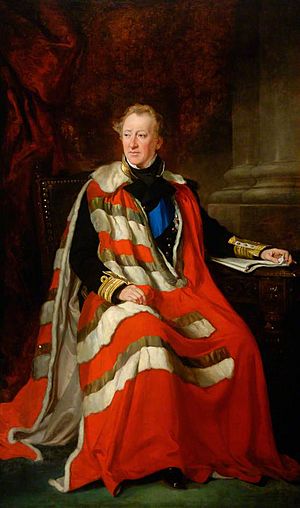Algernon Percy, 4th Duke of Northumberland facts for kids
Quick facts for kids
Admiral His Grace
The Duke of Northumberland
|
|
|---|---|

Duke of Northumberland by Francis Grant
|
|
| First Lord of the Admiralty | |
| In office 28 February 1852 – 17 December 1852 |
|
| Monarch | Queen Victoria |
| Prime Minister | The Earl of Derby |
| Preceded by | Sir Francis Baring, Bt |
| Succeeded by | Sir James Graham, Bt |
| Personal details | |
| Born | 15 December 1792 |
| Died | February 12, 1865 (aged 72) |
| Nationality | British |
| Political party | Conservative |
| Spouses | Lady Eleanor Grosvenor (d. 1911) |
| Parents | Hugh Percy, 2nd Duke of Northumberland Frances Julia Burrell |
| Alma mater | St John's College, Cambridge |
| Military service | |
| Allegiance | |
| Branch/service | Royal Navy |
| Years of service | 1805–c.1862 |
| Rank | Admiral |
| Commands | HMS Scout HMS Pelorus HMS Caledonia HMS Cossack HMS Driver |
| Battles/wars | |
| Awards | Knight of the Order of the Garter |
Admiral Algernon Percy, 4th Duke of Northumberland (born 15 December 1792, died 12 February 1865) was an important British figure. He was a naval commander, an explorer, and a Conservative politician. From birth until 1816, he was known as Lord Algernon Percy. Later, from 1816 to 1847, he was called The Lord Prudhoe.
Contents
Early Life and Education
Algernon Percy was born into an important family. His father was Hugh Percy, 2nd Duke of Northumberland. His mother was Frances Julia Burrell. Algernon was their second son. He went to school at Eton. After that, he studied at St John's College, Cambridge.
Algernon Percy joined the Royal Navy in March 1805. He was only 12 years old. He served on HMS Tribune. He fought in the Napoleonic Wars. By 1815, at just 22, he became a captain. He took command of HMS Cossack.
In 1816, when he was 23, he received the title Baron Prudhoe. This title came from Prudhoe Castle in Northumberland. He also loved to explore. From 1826 to 1829, he joined an expedition. They traveled to Egypt, Nubia, and The Levant. In 1834, he went to the Cape of Good Hope. There, he studied stars with John Herschel. They looked at the constellations in the southern sky.
Helping Save Lives at Sea
Northumberland cared deeply about sailors. From 1851 to 1865, he was president of a special group. It was called the National Institution for the Preservation of Life from Shipwreck. He helped reorganize this group. In October 1854, he changed its name. It became the Royal National Lifeboat Institution.
In 1851, he offered a prize of £200. He wanted a new design for a self-righting lifeboat. This means a boat that can flip itself back upright. James Beeching won the prize. His design became the standard for the new lifeboat fleet. In 1862, he became a full admiral in the Royal Navy.
Political Life
In 1847, Algernon Percy became the 4th Duke of Northumberland. This happened after his older brother passed away without children. In 1852, he joined the Privy Council. This is a group of advisors to the monarch. He was also made First Lord of the Admiralty. This meant he was in charge of the Royal Navy. He also had a seat in the cabinet. He held this important job until December 1852. In 1853, he was made a Knight of the Garter. This is a very high honor in Britain.
Personal Life and Legacy
Northumberland married Lady Eleanor Grosvenor in 1842. He was 49 years old at the time. They did not have any children. He passed away in February 1865 at Alnwick Castle. He was 72 years old. He was buried in Westminster Abbey. His cousin, George Percy, became the next Duke.
Northumberland was a member of many important societies. These included the Royal Society and the Royal Geographical Society. He was also a good friend of the Arctic explorer Sir John Franklin. Prudhoe Bay in Alaska was named after him. This shows how much he was respected.
See also

